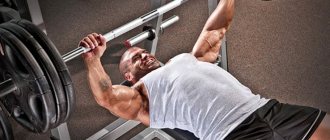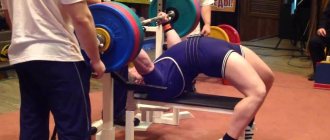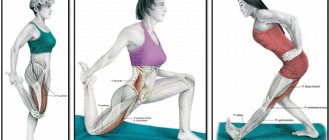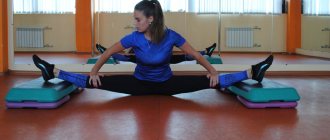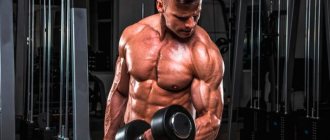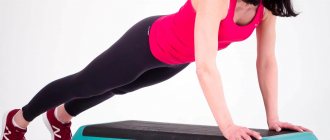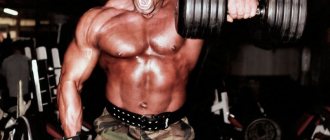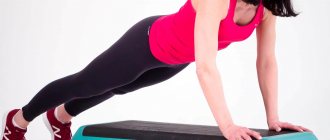- October 8, 2018
- Workouts in the gym
- Valery Savelyev
When visiting the gym, athletes try to give their buttocks a beautiful round shape. But then a month passes, then another, and they have remained virtually unchanged. Why don't my buttocks grow? The answer to this question depends on a number of factors. Let's look at them in more detail in the article, and also provide expert advice for solving the noted problem.
An integrated approach to solving the problem
Why don't my buttocks grow from strength training? This question can often be heard from athletes and sportswomen who regularly visit the gym. To understand the answer to this question, it is necessary to remember that the buttocks, along with the rest of the muscles of the legs and back, are the largest muscle groups in the human body. This means that it is very difficult to pump them up compared to, for example, the relatively small muscles of the arms or chest. Therefore, it is important to properly plan your training program.
Although exercise is one of the key factors in answering the question of why the buttocks are not pumping up, it is not the only one. Thus, proper nutrition and adequate rest also play an important role in achieving your goal.
Buttock muscles
Before moving on to the question of why the buttocks do not grow, you should understand what they are from an anatomical point of view. The butt musculature consists of three main muscles:
- Big. This is the muscle that is actually known as the “buttock”. Whenever a person moves with the legs, it bears the main load, so almost any exercise for the lower body involves the large muscle in the work.
- Average. It is located immediately under the large muscle. Its function is to ensure the vertical position of the human body while walking.
- Small. This muscle is located under the large and medium, it has a triangular shape. The primary function of the gluteus minimus muscle is to support body weight, primarily when a person uses one leg for support.
The given description of the structure of the muscles of our butt must be taken into account when drawing up the correct training program, including training complexes that load each of the three muscles.
How do the buttock muscles grow?
Considering the answer to this question will help the athlete understand what mistakes he is making and what needs to be changed in his training process. So, the muscles of the buttocks increase their volume and grow in the same way as any other muscles in the human body. That is, she must receive sufficient intense physical activity, as well as the required amount of energy calories and building material (protein).
After receiving significant physical activity, when the athlete brings his muscles to exhaustion and literally “destroys” them, the recovery process begins (after approximately 20-24 hours, this time is known as the “protein window”). “Damaged” muscles begin to remove breakdown products (lactic acid) from their tissues and require the body to supply amino acids. This is a key point in its growth; here you must always remember that an increase in muscle volume occurs only at rest, and only in the presence of sufficient “building” material.
After the questions of the structure and mechanism of muscle growth have been discussed, we can move on to indicating the reasons why it does not increase in volume, although the athlete makes some physical efforts for this.
What influences the result
The buttocks, like other muscle groups, grow subject to several factors:
- Sufficient physical activity
In order for muscles to increase, they need a push. Regular and intense training is a must for growth.
The last 3-5 reps of a set should be hard (with proper technique), otherwise you're just doing general conditioning and strengthening of the body.
Muscles will not grow from low loads.
- Required amount of protein in the diet and total calories
For growth, you need an excess of calories (+150-200 kcal to the daily norm) and protein so that you have something to build muscles from.
The recommended protein intake per day is 1.5-2 g per 1 kg of your body weight. That is, a girl weighing 50 kg needs 75-100 g of protein per day.
Muscles grow not during, but after training, when the body recovers from stress.
Therefore, 7-8 hours of sleep, an adequate amount of exercise per week and a lack of stress should become your routine.
How long it takes to pump up your butt will depend on these three components.
If your workouts are half-hearted, you don’t follow the principles of proper nutrition and you recover poorly, then you won’t be able to achieve rounded shapes.
Genetic factor
Perhaps this is one of the important reasons why the buttocks do not grow. Different people's muscle mass responds differently to exercise. For some, a month of training is enough, and they already look fit and pumped up, while others need to train for six months or longer and make significant physical efforts to at least slightly increase muscle volume. In any case, it should be remembered that the muscles of each person are a trainable object, therefore, through willpower you can always influence genetics.
How long does it take to pump up your butt?
Due to the individual characteristics of each girl, it is not easy to predict how long it will take to pump up the buttocks.
But as soon as you add physical activity, the first results will not keep you waiting after 1-1.5 months.
During this time, the muscles will acquire the necessary tone and become more toned, as they will be regularly involved in work.
The speed of the result also depends on whether you work out in the gym or at home.
In the gym
By training in the gym, you can add a few centimeters to your buttocks in 3-6 months. And to achieve a significant increase in volume - after 6-12 months of regular exercise and adherence to the regime.
Exercises with a barbell, dumbbells and in exercise machines will pump up your butt much faster.
By training with additional weight, you can develop greater force and better challenge your muscles. This stimulates the release of necessary hormones into the blood and accelerates metabolism.
Muscles must constantly adapt to new loads in order to grow. And in the gym it is easy to create such conditions. All you have to do is add weight to the bar.
At home
You can enlarge your butt by working out at home. But muscles will grow up to a certain point.
Such workouts will be enough for beginners or those who want to add a little tone and overall fit to their buttocks.
The results from home training appear in about 4-6 weeks.
But progress may stop after a while, depending on your level of preparation. By continuing to exercise at home, you will simply be maintaining what you already have.
Training intensity
This is the most important aspect for the growth of not only the buttocks, but also muscle mass in general. It is necessary to exercise at such a pace and perform exercises of such complexity and severity that the muscles literally “tear” and “break”; only in this way can the subsequent effective process of their recovery, accompanied by weight gain, be started. Otherwise, that is, with cyclical training of the same type and not hard, the muscles adapt to the load, stagnate and do not receive any development.
Nutrition issue
This has already been mentioned above: if there is no supply of high-quality “building” and energy material to the body, then all physical exercises are reduced to nothing. Moreover, they not only do not lead to the growth of muscle mass in the buttocks, but even the opposite. Without proper nutrition, the body becomes depleted and the volume of this very mass decreases.
Take care of recovery
I want to say that if you do not create conditions for proper rest (recovery), then the growth of your butt will slow down or stop completely. So the choice is yours.
With a lack of sleep, weakness, fatigue, drowsiness, etc. occur... what kind of training is there... strength indicators, strength endurance and neuropsychic activity decrease..
And in general, without sufficient (without good) sleep, both your mood and your composure, determination, desire to train, etc. disappear.
If for an ordinary person (i.e., not involved in sports) sleep is so important for normal life, imagine the role of sleep for a person working out in the gym...
With a lack of sleep, your muscle tissue (your muscles) will begin to break down, and all because lack of sleep or no sleep at all increases the manifestation of catabolism.
What is our goal? That's right - muscle growth (emphasis butt)... draw your own conclusions.
RECOVERY is generally a complex concept (not just sleep), which is influenced by absolutely everything in your life. Any STRESS outside of training slows down recovery. Remember this when, for example, you are nervous, lack of sleep, etc. In general, along with proper training + nutrition = what was said in this paragraph will be enough. I have nothing more to tell you.
Kinetic chain
In relation to the topic under consideration, this phrase should be understood as the sequence of inclusion of various muscles in work during the targeted training of specific muscle fibers and, as a result, their proportional development. The idea behind the kinetic chain is that by training just your glutes, you won't be able to achieve significant glute size without focusing on other muscle groups, such as your quads, hamstrings, and abdominals.
After we have listed the main reasons why girls and boys cannot pump up their butts, let’s move on to solving the problem.
Well-designed training plan
What should you do to make your buttocks grow? Of course, it’s right to put stress on them. To do this, firstly, you need to train regularly 2-3 times a week. Results will not come immediately and may take several months to begin to appear. Secondly, your training program should include intense exercise of a varied nature, that is, not just running on a treadmill or doing squats. You should do both, while constantly modifying the exercises and “surprising” the muscles with new types of loads. Thirdly, exercises with additional weight help to load the muscles properly and help increase the efficiency of gaining lean body mass, therefore it is recommended to include exercises with dumbbells, barbells and various strength training equipment for the lower body in training complexes.
Let us note one important feature that mainly girls need to know about. The buttocks will appear large against the background of a narrow waist. Moreover, these are two parts of a woman’s body that determine her attractiveness in the eyes of men. This means that in your exercise program you need to pay important attention to the abdominals and the appearance of the waist.
What is maltodextrin eaten with?
In infant formulas and cereals, sports and dietary nutrition, this additive is used to increase nutritional value and improve digestibility. In buns and waffles, sweets and gingerbreads, ice cream and puddings - to improve taste and appearance, to increase shelf life. In sausages and deli meats, maltodextrin is used as a fat substitute and to improve consistency. It is added to seasonings, sauces and drinks as a flavor enhancer and sugar substitute. In instant foods, it acts as a leavening agent, prevents crystallization and improves the solubility of powdered ingredients. In addition, fruits are sprayed with a maltodextrin solution to protect them from damage by insects and preserve their presentation during transportation and storage.
Those who love homemade sweets will also find this article about agar-agar, a plant-based analogue of gelatin, useful.
The best exercises for the buttocks
What to do if your buttocks don't grow? Include exercises in your training regimen that will stimulate their development in the most effective way. Today you can find a huge number and variety of training programs for the butt. Below are exercises that will not let you down. They must be practiced by an athlete if he wants beautiful buttocks:
- Hip lift. Any movement that involves lifting the hips, such as stepping up stairs or running with high legs, effectively engages the glutes. In the training program, this type of movement should be given fundamental attention in order to enlarge your buttocks. To be fair, we note that squats of any kind work the quadriceps and the muscles of the lower thigh to a greater extent. Nevertheless, the buttocks also receive the necessary load. There are many types of this exercise that have been developed. In addition to classic squats, we note the following: Bulgarian (one leg is located behind the body and the toe of the foot rests on the bench, the second leg holds the main weight of the body during the exercise); with widely spaced legs or “sumo” type (performed like classic ones, only the legs are located much wider than the width of the athlete’s shoulders); Brazilian (they have become fashionable in recent years, they are performed like this: the athlete stands straight, feet shoulder-width apart, then one leg is put to the side, and the body weight is transferred to the second leg, after which a squat is performed, then the legs change).
- Leg lunges. This exercise is similar to Bulgarian squats, only the back leg rests not on the bench, but on the floor.
- Jumping. This is an energy-intensive type of exercise that trains not only the muscles of the legs and buttocks, but also the athlete’s respiratory and cardiovascular systems.
- Use of simulators. It can be a stepper, static or elliptical bike.
It is recommended to perform these exercises in series (2-3) of 10-15 repetitions each. During training, it is preferable to perform several types of exercises, for example, 3-4, and the next session use another 3-4 types.
General Tips
In order for your buttocks to grow, your whole body to look healthy, and your mood to be good, you need to remember the three pillars of a healthy lifestyle: physical activity, proper nutrition and sleep.
A lot has already been said about physical activity, but here we just note that the use of additional weight should be started gradually. The main criterion is that the athlete can perform 10-15 repetitions with an average effort; if he cannot do this, then the weight of the equipment is too heavy for him.
Another important point is the technique of performing the exercises. In order to increase the effectiveness of training and avoid injury, it is necessary to learn how to breathe correctly and perform each exercise correctly.
What should you eat to grow your buttocks? The daily diet should consist of fruits and vegetables, which will provide the body with a basic set of vitamins and plant fibers, as well as protein foods (fish, meat, dairy products).
As for the issue of sleep, it is recommended to adhere to a constant schedule and sleep 7-9 hours a day.
Eat well
In addition to the above exercises, you also need to change your diet. Basically, you need to focus on adding more protein so that the muscles have the material to “build” a nice butt.
Eating the right foods helps in regulating hormones. Moreover, a healthy diet also improves the effects of exercise, the main thing is to find out your exact calorie intake.
Squirrels
There are many ways to add protein to your diet. Some good sources of protein: skim milk, eggs, low-fat yogurt, fish, turkey, legumes, meat.
Fats
The gluteal muscles are covered with a layer of fat. To get a bigger and very beautiful butt at home, you should eat unsaturated fats: fish oil, avocado, nuts and seeds, fatty fish, sunflower oil, olive oil and peanut oil.
Consult your dietitian or download a calorie counting app to find out how much fat you can consume per day.
Microelements
Micronutrients are nothing but vitamins and minerals that are very important for the proper functioning of our body. Fruits, vegetables, nuts and legumes are excellent sources of micronutrients. As you work out, eat plenty of fruits and vegetables to keep your body from getting tired from lack of energy.
Carbohydrates
Carbohydrates are important to consume (you can't ignore them completely). The amount of carbohydrates depends on the intensity of training. Good sources of carbohydrates: brown rice, barley, corn, wheat bread, apples, potatoes and grapefruit
Good sources of carbohydrates: brown rice, barley, corn, wheat bread, apples, potatoes and grapefruit.
